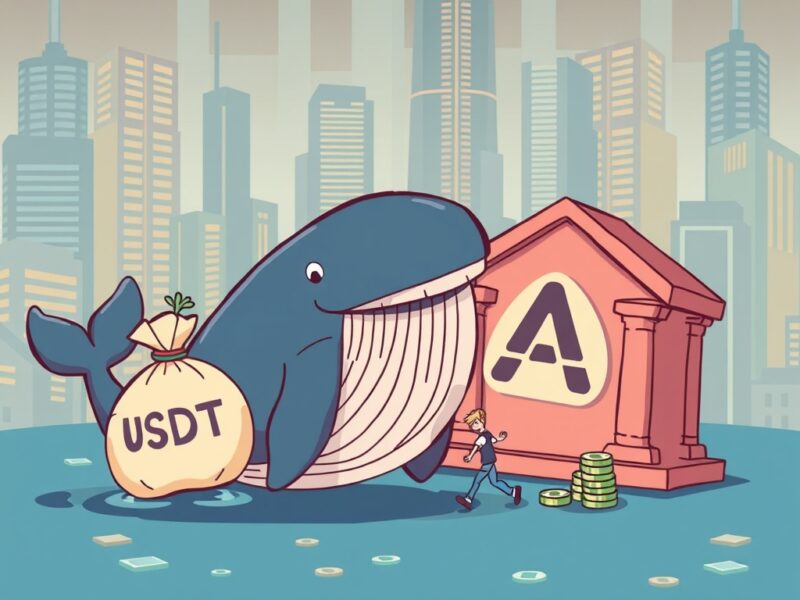Massive USDT Transfer to Aave: What This $200 Million Move Reveals for DeFi
0
0

BitcoinWorld

Massive USDT Transfer to Aave: What This $200 Million Move Reveals for DeFi
A colossal movement of digital assets has recently captured the attention of the cryptocurrency community. Specifically, a staggering 200,000,000 USDT transfer to Aave from an unknown wallet has been reported by Whale Alert. This transaction, valued at approximately $200 million, signals a significant event within the decentralized finance (DeFi) ecosystem. What does such a massive influx of stablecoin mean for Aave, and what are the broader implications for the crypto market?
Understanding the Enormous USDT Transfer to Aave
When we talk about a ‘whale’ in the crypto world, we are referring to an individual or entity holding a substantial amount of cryptocurrency. A ‘whale alert’ signifies a large transaction that often warrants closer examination due to its potential market impact. In this instance, the USDT transfer to Aave involves 200 million units of Tether, the largest stablecoin by market capitalization.
Aave is a leading decentralized lending and borrowing protocol. It allows users to lend out their crypto assets to earn interest or borrow by providing collateral. The arrival of such a large sum of USDT into Aave’s liquidity pools can have various ripple effects, influencing everything from lending rates to market sentiment.
Why is This Specific USDT Transfer to Aave So Significant?
A $200 million deposit is not an everyday occurrence, even in the fast-paced world of DeFi. This particular USDT transfer to Aave stands out for several reasons:
- Increased Liquidity: The immediate impact is a significant boost in Aave’s liquidity. More USDT available means more capital for borrowers and potentially more stable interest rates for lenders.
- Market Confidence: A large deposit from an ‘unknown wallet’ could indicate a major institutional player or a high-net-worth individual is gaining confidence in Aave’s platform and the broader DeFi space.
- Potential for Yield: The whale might be seeking to earn yield on their substantial USDT holdings, leveraging Aave’s lending mechanisms. This move suggests a strategic financial decision.
Potential Impacts on Aave and the DeFi Ecosystem
What could this substantial USDT transfer to Aave mean for the protocol itself and the wider DeFi landscape? The implications are multifaceted:
For Aave:
- Enhanced Stability: Increased liquidity in USDT pools can lead to greater stability in lending and borrowing rates for this specific asset.
- Attracting More Users: Such a large deposit might attract other users, both lenders and borrowers, who see the deep liquidity as a sign of a robust and reliable platform.
- Governance Influence: If the unknown wallet holds Aave governance tokens, this move could potentially signal an intention to participate more actively in the protocol’s future decisions.
For DeFi:
- Validation of Protocols: Major transactions like this validate the operational efficiency and security of established DeFi protocols like Aave, reinforcing trust in decentralized finance.
- Stablecoin Dominance: It underscores the critical role stablecoins play in DeFi, acting as a bridge for large capital movements and a stable store of value within volatile markets.
What Are the Broader Implications of a Large USDT Transfer to Aave?
Beyond Aave itself, a USDT transfer to Aave of this magnitude can spark wider discussions and observations. Is this a precursor to increased institutional involvement in DeFi? Or is it simply a large investor optimizing their capital for yield?
While the identity of the ‘unknown wallet’ remains a mystery, the move highlights the transparency inherent in blockchain transactions. Anyone can observe these movements, even if the parties involved remain pseudonymous. This transparency is a core tenet of decentralized finance.
Navigating Whale Movements: Actionable Insights for Investors
Observing significant transactions, such as this USDT transfer to Aave, can provide valuable insights. However, it is crucial to interpret them with caution. Here are some actionable insights:
- Monitor Liquidity: Keep an eye on liquidity pools for assets you hold or plan to interact with. High liquidity can mean better rates and lower slippage.
- Understand Market Dynamics: Large stablecoin deposits can sometimes precede significant market moves, as whales might be positioning themselves for future opportunities.
- Diversify and Research: Never put all your eggs in one basket. Always conduct thorough research before investing in any DeFi protocol or cryptocurrency.
The 200,000,000 USDT transfer to Aave is a powerful reminder of the dynamic and rapidly evolving nature of the decentralized finance world. It underscores the growing confidence in established protocols like Aave and the increasing sophistication of capital deployment within the crypto ecosystem. While the specific motivations behind this whale’s move remain speculative, its impact on Aave’s liquidity and the broader DeFi narrative is undeniable. It’s a testament to the ongoing maturation of decentralized financial services.
Frequently Asked Questions (FAQs)
1. What is Aave?
Aave is a decentralized non-custodial liquidity protocol where users can participate as depositors or borrowers. Depositors provide liquidity to earn passive income, while borrowers can obtain loans by offering collateral.
2. What is USDT (Tether)?
USDT, or Tether, is a stablecoin pegged to the US dollar. This means its value is intended to remain stable at $1, making it a popular choice for traders and investors seeking to avoid the volatility of other cryptocurrencies.
3. What does ‘unknown wallet’ mean in a crypto transaction?
An ‘unknown wallet’ refers to a cryptocurrency address that has not been publicly identified or linked to a specific individual or entity. While the transaction is transparent on the blockchain, the owner’s identity remains private.
4. How does a large USDT transfer to Aave affect interest rates?
A large USDT transfer to Aave significantly increases the supply of USDT available for lending. According to Aave’s dynamic interest rate model, an increased supply typically leads to lower borrowing rates and potentially lower lending rates, assuming demand remains constant.
5. Is a whale transfer always a positive sign?
While a large deposit often indicates confidence, it’s not always exclusively positive. Such large movements can also signal an intention to borrow heavily, potentially impacting utilization rates, or even a precursor to withdrawal, which could decrease liquidity. It’s important to analyze the context.
If you found this analysis insightful, consider sharing it with your network! Stay informed about the latest developments in decentralized finance by sharing this article on your favorite social media platforms.
To learn more about the latest crypto market trends, explore our article on key developments shaping DeFi protocols and their institutional adoption.
This post Massive USDT Transfer to Aave: What This $200 Million Move Reveals for DeFi first appeared on BitcoinWorld and is written by Editorial Team
0
0
 Manage all your crypto, NFT and DeFi from one place
Manage all your crypto, NFT and DeFi from one placeSecurely connect the portfolio you’re using to start.







